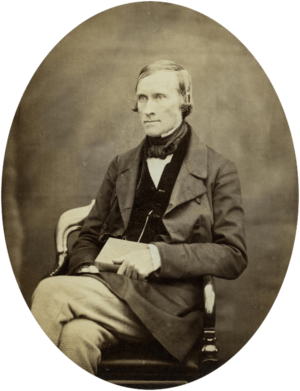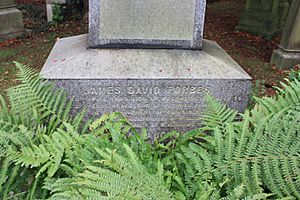James David Forbes facts for kids
Quick facts for kids
James David Forbes
|
|
|---|---|
 |
|
| Born | 20 April 1809 Edinburgh, Scotland
|
| Died | 31 December 1868 (aged 59) Clifton, Bristol, England
|
| Alma mater | University of Edinburgh |
| Awards | Keith Prize of the Royal Society of Edinburgh (1833-5, 1841–3, 1863–5) Rumford Medal of the Royal Society (1838) Gold Medal of the Royal Society (1843) |
| Scientific career | |
| Fields | Physics Glaciology |
| Institutions | Professor of Natural Philosophy, University of Edinburgh (1833–60) Principal of the United College, St Andrews (1860–8) |
| Notes | |
|
Member of the Highland Society (1836)
Resting place: Dean Cemetery, Edinburgh |
|

James David Forbes (1809–1868) was an important Scottish scientist. He was a physicist and glaciologist, which means he studied how heat moves and how glaciers behave. Forbes spent most of his life in Edinburgh, Scotland. He studied at the University of Edinburgh and later became a professor there. In 1859, he became the head of the United College of St Andrews.
Forbes was also an inventor. In 1842, he created an inverted pendulum seismometer, a device used to detect and measure earthquakes.
Contents
Early Life and Education
James David Forbes was born on April 20, 1809, in Edinburgh. He was the fourth son of Sir William Forbes, 7th Baronet, a well-known figure.
He started studying at the University of Edinburgh in 1825. Even at a young age, he began writing scientific papers. He used the secret name "Δ" when publishing them.
Becoming a Scientist
Forbes became a member of the Royal Society of Edinburgh when he was just 19 years old. In 1832, he was also chosen to join the Royal Society of London. These were big achievements for a young scientist!
Sir David Brewster, another famous scientist, encouraged Forbes to do his own research. A year later, in 1833, Forbes became a professor of natural philosophy at the University of Edinburgh. He was a very active teacher and helped improve the university. In 1859, he became the head of the United College of St Andrews, a position he held until he passed away in 1868.
Discoveries and Research
Forbes is most famous for his work on heat and glaciers. He made many important discoveries that helped us understand these topics better.
How Heat Behaves
Between 1836 and 1844, Forbes published several studies on heat. He showed that certain materials, like tourmaline and mica, could affect infrared heat rays. He found that these materials could make heat waves behave in a special way called polarisation.
His work on heat earned him the Rumford Medal in 1838. In 1843, he received the Royal Medal for his research on how clear the air is and how sunlight passes through it.
Studying Earthquakes
After a series of earthquakes in Comrie, Scotland, in 1839, scientists wanted better ways to detect them. Forbes helped by creating one of the first modern seismometers. This device used an inverted pendulum with a pencil to record ground movements on paper. While the first designs needed improvements, it was an early step in earthquake detection.
Heat in the Earth
In 1846, Forbes started experiments to measure the temperature of the earth at different depths. He studied how heat moves through different types of soil and rock. Later in his life, he also showed that iron conducts heat less effectively as it gets hotter.
Understanding Glaciers
Forbes became interested in how glaciers move in 1840. He traveled to Switzerland and Norway to collect information. He believed that glaciers are like a very thick, slow-moving fluid. They slide down slopes because of the pressure within them.
His ideas led to some debates with other scientists, but his work was supported by famous art critic John Ruskin. Forbes's detailed observations greatly advanced our understanding of glaciers.
Measuring Boiling Points
During his trips to study glaciers, Forbes also measured the boiling point of water at different heights. He published this data in 1857. This information is still useful today for scientists studying how to analyze data. It shows how complex relationships can be simplified and why it's important to check for unusual data points.
Other Interests and Legacy
Forbes was also interested in geology, the study of Earth's rocks and features. He wrote about hot springs, old volcanoes, and the geology of certain hills in Scotland.
He wrote several books, including Travels through the Alps of Savoy (1843) and Norway and its Glaciers (1853). He also wrote a section on science for the Encyclopædia Britannica.
The Forbes River and Forbes Glaciers in New Zealand are named after him. A mountain peak in the Mont Blanc massif is also called Aiguille Forbes.
James David Forbes was a deeply religious person. His personal letters, collected in the book "Life and Letters of James David Forbes" (1873), show his strong Christian faith.
He passed away on December 31, 1868, and is buried in Dean Cemetery in Edinburgh. His grave is marked by a large stone Celtic cross. His wife, Alicia Wauchope, is buried with him. His son, George Forbes, also became a scientist.
See also
 In Spanish: James David Forbes para niños
In Spanish: James David Forbes para niños


